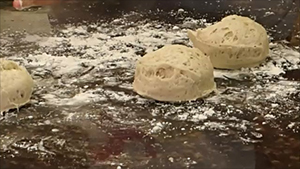

Englewood–If you are on a gluten-free diet and fear the coming avalanche of holiday meals beginning with challah you can’t eat–or substitutes you’d rather not eat–you now have another option. Orly Gottesman, creator of Blends By Orly gluten-free flours, says you can make delicious gluten-free challah using her Manhattan Blend. The Manhattan Blend is one of six blends, each created to make a specific kind of bread or pastry (see Jewish Link, September 11, page 45). Here are Gottesman’s directions for making soft, fluffy, gluten-free challah rolls or loaves.
Use your favorite challah recipe and substitute Manhattan Blend for the flour, or try the recipe included in this article. If using your own recipe, add 25–30% more water than the recipe calls for. Gluten-free breads can be unpleasantly dry if they don’t have enough moisture. After making the dough, oil the bottom of a bowl, put in the dough and oil the top. Cover the bowl with plastic wrap and leave for several hours or overnight in the refrigerator. Gluten-free dough doesn’t have the flexibility or elasticity of regular challah. It is firmer and easier to work with when cold.
When you are ready to shape the dough, keep two small bowls nearby, one with flour and one with oil. You can dip your hands in either one, as you work the dough to keep it from sticking. Using oil gives you a browner, shinier crust. Dust the counter with flour.
Use a large ice cream scoop to give you consistently sized balls of dough. Scoop up some dough and wipe on the side of the bowl to flatten. Release onto your floured counter top. Put a little flour on top to prevent sticking. If you want plain rolls, put them on a baking sheet with parchment paper. For knots and loaves, the dough has to be rolled into long strands, or ropes.
The gluten-free dough will feel mushy but when rolled in flour you can manipulate and shape it. Roll the dough very gently with both hands; you can’t pull it or it will break. Gottesman’s favorite saying is, “You control the dough; the dough does not control you.”
For a knot, form a circle with the rope, bringing one end under the strand and into the middle. For a plaited loaf, roll each ball into a strand, however many you want, and pinch the ends together. Plait like regular challah only much more gently, using either some flour or oil on your hands to prevent sticking. The flour on the counter also prevents sticking and coats the top of the dough. Gottesman says the dough is soft, like play dough, so you must be careful to avoid breaking the strands.
After shaping and placing on the parchment-paper-covered baking sheet, coat with egg wash, again with a gentle motion. Cover with a towel, to keep the dough from drying out, and put in a warm place to proof. Gottesman puts her challah in an oven set at 100°.
The dough is ready when it has doubled in size, which takes 45–60 minutes. Put on another coat of egg wash and any toppings you want such as sesame seeds or sugar and cinnamon. Bake at 375° for the time stated in your recipe, but watch carefully as gluten-free dough bakes more quickly.
When the rolls or loaves look finished–dark brown and shiny–touch one gently. If it feels firm, and you hear a hollow sound when you tap, take the challah out of the oven.
Wishing everyone a happy, healthy Challah-day!
Orly Gottesman’s Gluten Free Recipe for 5 Challahs or 40 4-oz. Rolls
6¼ cups warm water (105–115°)
1¼ oz. dry yeast
1 tbsp. plus 2 tsp. sugar
5 lb. Manhattan Blend
7.5 oz. oats or oat flour
2½ cups honey
4 tbsp. salt
3 large eggs
1½ cups oil
2½ tsp. vanilla (optional)
1 large egg lightly beaten
Pre-heat oven to 100° F. Combine water and yeast in the bowl of your stand mixer with the paddle attachment. Stir in the sugar and let it sit for five minutes until the yeast begins to bubble.
Add to the bowl honey, eggs, oil, and vanilla. Mix together until all ingredients are incorporated.
Cover the wet ingredients with 5 lbs. of flour and 4 tsps. of salt. Mix everything together on medium speed for three minutes. Then increase to high speed and let mix for another two minutes until all ingredients are incorporated. The dough should be sticky, but not wet like a batter.
Cover your bowl with a warm towel and place it in the oven set to 100°. Let the dough rise for about 45 minutes, or until it almost doubles in size.
Turn the dough out onto a surface floured with Manhattan Blend or white rice flour and punch down. Divide into five sections. Divide each section into three equally sized portions. Sprinkle flour on top of the dough to prevent it from sticking to your hands. Cover a sheet pan with parchment paper.
Carefully roll each portion into three long ropes and place them parallel to each other on the pan. Pinch the top ends together and braid the dough into a plait. You can dip your fingers in oil or water to help stick the ends of the dough together.
Repeat this with the remaining four sections. Egg wash each challah and place back into the oven set at 100°. Let them rise for 45 minutes to an hour uncovered, until the challah doubles in size.
Heat the oven to 375° F. Bake challahs for approximately 25 minutes, or until the outside is brown and you hear a hollow sound when tapped with your finger.
Eat fresh or double wrap the challahs in plastic, and freeze for up to 6 months.
By Bracha Schwartz










